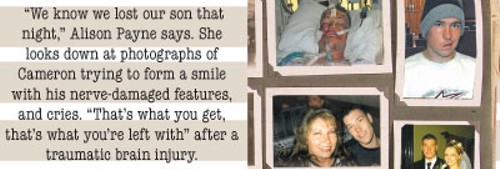Laura Boswell followed two corrections officers through a series of sliding doors into a silent, two-tiered hall, lined with 11 closed, solid-steel doors. One, on the bottom right, stood open.
The 28-year-old attorney from the Disability Law Center, which advocates for Utah’s disabled, had gone to Uinta 1, the Utah State Prison’s maximum-security wing to check up on 26-year-old inmate Jeremy Haas, following allegations by another inmate of abuse and neglect by the prison. First, she was to inspect Haas’ cell.
What struck her was how narrow it was. Bedding lay on a metal slab that jutted out from the wall, taking up half the cell’s space. There was a small sink, some crumpled papers and a line of small shampoo bottles.
“It was horrifying to me that somebody spends 23 hours a day there,” she says. “I’m not very tall, but I couldn’t have laid down across it.”
Haas was arrested in 2007, a week after his 18th birthday, and charged with robbery, possession of a stolen firearm, discharging a weapon within the city limits and reckless burning. A 2nd District Court judge in Ogden found Haas, who has an IQ of between 58 and 68, competent to stand trial.
Boswell’s colleague at the Disability Law Center, Aaron Kinikini, is the driving force behind a new initiative to bring more accountability to the prison’s treatment of mentally ill inmates. The standard for a defendant to be declared incompetent is so high, he says, “You must be a raving lunatic in front of a judge to have that track taken.”
Haas was sentenced to 1 to 15 years. Kinikini, who’s a former criminal defense attorney, says, “Your garden-variety criminal is probably going to do two years,” on a 1 to 15. Haas has already served six years.
That’s because inmates with mental-health diagnoses—Haas’ attorney described him in court as having “mild mental retardation”—are often unable to cope with the stress and regimentation of prison, which leads them to act up, say other prisoners, mental-health experts and relatives of Uinta 1 inmates. They say that rather than treat their mental-health needs, the prison keeps them in solitary confinement—administrative segregation, as the prison calls it—until they behave.
But “Once in segregation, continued misconduct, often connected to mental illness, can keep the inmates there indefinitely,” wrote Jeffrey L. Menzer, M.D., and Jamie Fellner in The Journal of the American Academy of Psychiatry and the Law.
City Weekly’s requests to interview staff and management at the prison were denied. In response to e-mailed questions, prison spokesman Steve Gehrke sent a statement noting that clinical considerations and security interests can often be “diametrically opposed, forcing housing and mental-health professionals to make tough decisions on a case-by-case basis. … The prison is asked by society to perform a difficult task, and it always seeks to do so in a way that both maintains security while showing appropriate compassion and care for individuals in its custody.”
The prison noted that there are areas that specifically are intended for treating and housing the mentally ill. However, “in rare circumstances, offenders prove they cannot be housed in that area without jeopardizing safety, and they must be moved for closer monitoring.”
Which brings them to the harsh embrace of Uinta 1.
“THE LOW SIDE”
Jeremy Haas is allowed 25 sheets of paper in Uinta 1. On four connected squares of toilet paper, he writes to City Weekly that those 25 sheets don’t last him long, “as Im a poet & love to write my thoughts & feelings as Im not on any med[ication] & writeing and drawing is the only way I can keep happy.”
Inmates are some of the few people who still correspond via handwritten letters. City Weekly has received correspondence from 10 or more inmates, all expressing concern over housing conditions in Uinta 1. The most eloquent advocate from Uinta 1 is one of its longest residents, Paul Payne, 37, who has been in prison for 21 years, currently serving five to life for aggravated robbery.
City Weekly identified four inmates, all in their 20s, all being held in Uinta 1, all with mental-health issues. Requests to interview Jeremy Haas, Cameron Payne (no relation to Paul Payne), Ryan Allison and Coleman Stonehocker were denied by the prison. The prison also denied City Weekly’s request to tour Uinta 1, citing security measures. A records request seeking the number of mentally ill inmates in the unit and the number of suicide attempts and suicides that have occurred there were denied on the grounds that the prison lacks the resources to compile such data.
The only way to ask inmates questions, then, is by letter. Three of the four responded. While grammar, spelling and syntax may be unorthodox, the words of these four men and those who advocate for them in neighboring cells paint a chilling picture.
Uinta 1 has a total of 96 single cells on two tiers, divided into eight sections. Three 12-cell sections, on what inmates call “the low side,” are used for what the prison calls “intensive management.”
Inmates in intensive management are allowed out one at a time, three times a week, for a 15-minute shower and an hour in a recreation yard. They are cuffed through the port in their cell door and guided backward by an officer holding a leash. Some have to wear a spit hood, a thick mouth-covering cloth with netting that covers an inmate’s head and prevents them from spitting at guards.
Inmate Jacob Vigil writes that the yard is “a tiny outside rec area with no work out/exercise equipment. In cold weather, the whole section has to share a flimsy dirty coat that does not keep you warm.” Inmates are allowed no visits, are offered no life-skills or other programs, and no personal phone calls. Legal access is only through the unit’s caseworker.
Inmates describe sections of Uinta 1 as akin to a 19th century asylum, where “95 percent of the time you can’t hear [neighboring cellmates] due to all these mental-health cases banging, yelling, crying, screaming, fighting [guards], breaking sprinklers, etc,” writes inmate Curtis Allgier, who’s currently awaiting trial on a capital murder charge for allegedly killing prison guard Stephen Anderson.
Paul Payne stresses he doesn’t want to dehumanize his fellow inmates by focusing only on their mental illness. “They are really likeable, and it’s the system’s abuses and failures that are ruining ... these guys and setting them all up to do a lot of time in prison,” he writes. “For instance, these guys have been duped by more seasoned prisoners into breaking their sprinklers which beyond all logic and sense is a third-degree felony.”
Kinikini argues that “there’s no valid or legal-based treatment for keeping someone in a hole. There just isn’t.” His and Boswell’s priority, he continues, is getting Haas and inmates in similar situations out of solitary confinement.
Boswell says that people outside of prison might have an impression that those housed in solitary confinement are there for horrendous acts. But, after her visit to “the hole,” she says, “What was so horrifying to me was here is a kid who has done none of that, but that’s where he found himself.” She pauses, her eyes glassy with unshed tears. “It’s a really rotten place.”
More by Stephen Dark
-
Call it a Comeback
Long mired in economic depression, Midvale’s Main Street dusts off its small-town charm.
- Sep 20, 2017
-
Love Letters
Correspondence between a young woman at the Topaz internment camp and her beloved sheds light on Trump's America.
- Sep 6, 2017
-
Triggered
Veterans Affairs exists to help vets. So why did the Salt Lake VA appoint an anti-veteran chief?
- Aug 30, 2017
- More »
Latest in Cover Story
Readers also liked…
-
Forget the family pedigree—Robert F. Kennedy Jr should not be the next president of the United States
Trojan Horse
- Jun 21, 2023
-
Women decry harassment and toxic culture at St. George auto dealership
Men at Work
- Oct 11, 2023







